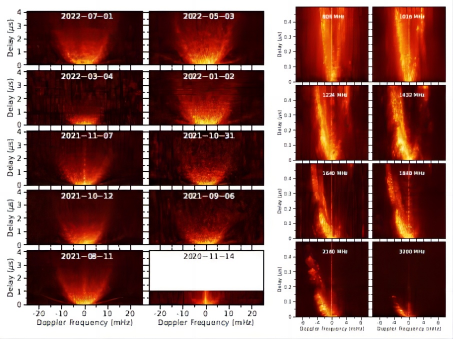The microstructure of the interstellar medium has been a hot topic of research in modern astrophysics. The turbulence and small-scale structures within the interstellar medium have profound implications for understanding the structure and evolution of the universe, providing crucial clues to address significant cosmic questions. However, directly observing these microstructures has long been challenging.
Recently, PhD student Zhen Wang, supervised by YUAN Jianping and WEN Zhigang at the Xinjiang Astronomical Observatory of Chinese Academy of Sciences, along with collaborators, employed radio observations of pulsars to detect these complex microstructures using the interstellar scintillation effect. This study utilized the Five-hundred-meter Aperture Spherical radio Telescope (FAST) in China and the ultra-wideband receiver of the Parkes radio telescope in Australia to conduct multiple observations of the swooshing pulsar B0919+06. Through high-resolution dynamic spectral analysis, they explored the characteristics of the interstellar medium.
The research presented dynamic spectra from all observations, as well as two-dimensional autocorrelation functions and secondary spectra, determining scintillation bandwidths, timescales, and drift rates. The frequency-dependent nature of scintillation parameters exhibited a single power-law spectrum behavior, suggesting that electron density fluctuations in the interstellar medium approximate a Kolmogorov spectrum. The secondary spectra displayed two distinct parabolic arcs, with their curvatures identified corresponding to outer and inner arcs. Under the assumption of isotropic scattering, the position of the scattering screen was estimated at approximately 157.3 and 726.0 parsecs. The inner scintillation arc appeared simultaneously over a broad frequency band, indicating it as a broadband phenomenon. The curvature of the arcs exhibited power-law variations with observational frequency, with a spectral index of -2.05, implying that the scattering screen spans a physical distance ranging from 689.7 to 883.3 parsecs from the pulsar.
This study utilized the scintillation phenomenon of pulsars to probe the microstructure of the interstellar medium, offering a new perspective on understanding its physical properties. Through precise measurements of scintillation parameters and characteristics of secondary spectra, the distribution and fluctuation properties of electron density within the interstellar medium were inferred, holding profound implications for comprehending the universe's structure and evolution.
The findings of this study were published in The Astrophysical Journal (ApJ, 2024, 968, 109).

Figure: The secondary spectra of PSR B0919+06 detected with the FAST and Parkes radio telescopes.